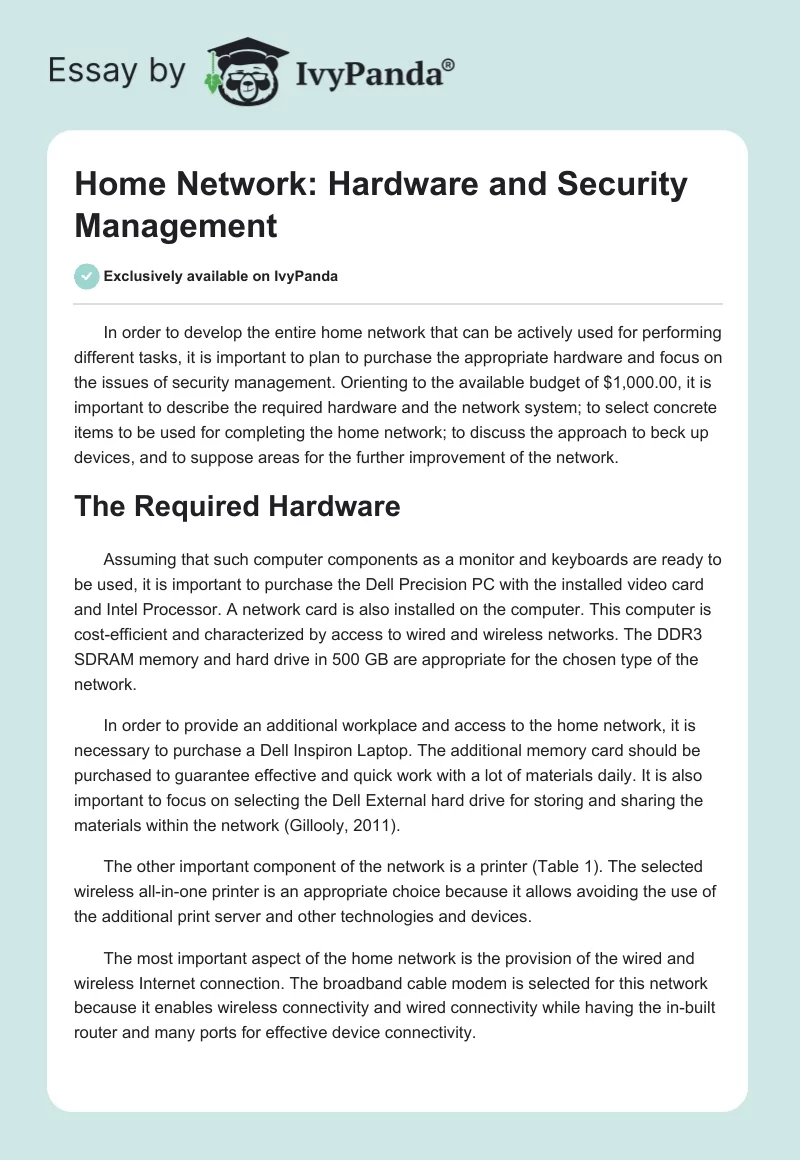In order to develop the entire home network that can be actively used for performing different tasks, it is important to plan to purchase the appropriate hardware and focus on the issues of security management. Orienting to the available budget of $1,000.00, it is important to describe the required hardware and the network system; to select concrete items to be used for completing the home network; to discuss the approach to beck up devices, and to suppose areas for the further improvement of the network.
The Required Hardware
Assuming that such computer components as a monitor and keyboards are ready to be used, it is important to purchase the Dell Precision PC with the installed video card and Intel Processor. A network card is also installed on the computer. This computer is cost-efficient and characterized by access to wired and wireless networks. The DDR3 SDRAM memory and hard drive in 500 GB are appropriate for the chosen type of the network.
In order to provide an additional workplace and access to the home network, it is necessary to purchase a Dell Inspiron Laptop. The additional memory card should be purchased to guarantee effective and quick work with a lot of materials daily. It is also important to focus on selecting the Dell External hard drive for storing and sharing the materials within the network (Gillooly, 2011).
The other important component of the network is a printer (Table 1). The selected wireless all-in-one printer is an appropriate choice because it allows avoiding the use of the additional print server and other technologies and devices.
The most important aspect of the home network is the provision of the wired and wireless Internet connection. The broadband cable modem is selected for this network because it enables wireless connectivity and wired connectivity while having the in-built router and many ports for effective device connectivity.
The wired components of the system should be connected with the help of appropriate cables. While focusing on the use of the broadband cable modem with the in-built router, it is possible to guarantee that all the selected hardware devices have access to both wireless and wired connections, and the broadband connection is provided. All the selected components can be purchased while using the budget of $1,000.00.
Table 1. The Costs of Required Items at Amazon.com
(Amazon.com, 2015).
The Approach to Back up the Devices
The most economically advantageous approach to back up the devices used in the home network is the use of the external hard drive. It is appropriate to use it being shared from the computer with the help of the network. This type of backup is rather easy and appropriate for the undeveloped or small home network. Furthermore, it is possible to refer to the use of the local area network for storing and sharing the materials (Mombrea, 2015).
It is also important to guarantee the creation of accesses and accounts for the users of the network, and it is necessary to secure the IP address and the modem/router in order to ensure its safety for sharing the information securely and easily with paroles. Thus, the wireless local area network for sharing the file is effective when it is secured (Gillooly, 2011). In combination with the use of the external hard drive, the appropriate level of storage and sharing the information can be guaranteed for the small home network.
Approaches to Enhance the Network
While having an additional $1,000.00 to enhance the network, it is necessary to purchase the other two laptops in order to improve the current infrastructure of the home network. The rest sum of money can be used to improve the storage of the information and redundancy aspects with the help of purchasing the network-attached storage.
This approach to back up devices is effective when there are more than two computers or laptops used in the system and when there are many additional devices used for sharing and storing the information. The network-attached storages are appropriate to share several folders and to be connected with all the computers and laptops as well as other devices in the system (Gillooly, 2011). Furthermore, these storage devices can guarantee the recovery of the damaged of lost data.
Conclusion
The development of the home network is a not challenging task where significant financial resources are available. However, the selection of the necessary hardware should be careful when the amount of available money is limited because of the necessity to create a secured home network that is appropriately protected from intrusions.
References
Amazon. (2015). Web.
Gillooly, J. (2011). How to build a home network: routers, connections, storage. Web.
Mombrea, M. (2015). The best home backup plan options – Part 3: External drive backup. Web.


